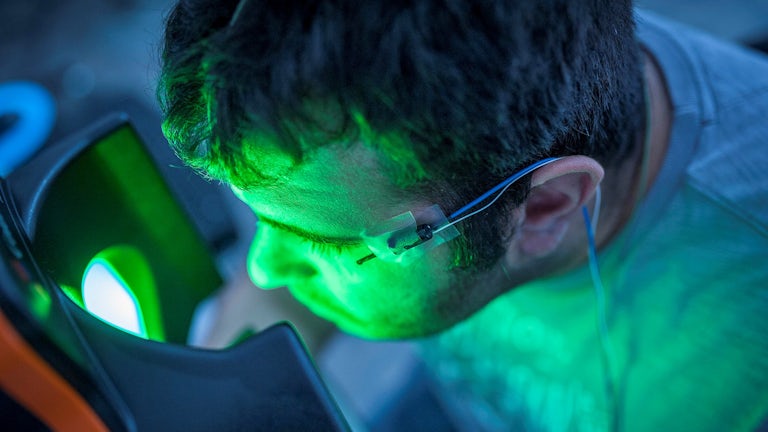We are a multi-disciplinary group whose focus is on biological structure, and how this provides ocular tissues with their vital mechanical and optical properties. We are investigating these structure-function relationships in the cornea, crystalline lens, sclera and lamina cribrosa.
Our work pays particular attention to the hierarchical structure of the cornea since this involves important intermolecular and interfibrillar interactions, which can lead to loss of vision. In addition, understanding the developmental mechanisms of ocular structures is leading to several different tissue replacement methodologies including exploitation of stem cells and the development of artificial corneal implants.
Aims
To determine structure-function relationships in the eye in health and disease, and drive the development of new and improved treatments for ocular disorders.
Research
Using state-of-the-art structural analysis technology, our research continues to improve understanding of the structural basis of ocular function in health, disease and following surgery, and to drive the development of new treatments for ocular disorders. Key areas of investigation include:
- corneal development
- corneal transparency
- corneal refractive surgery
- ocular pathologies, such as corneal diseases, cataract formation and glaucoma
- new therapies for ocular disorders, such as keratoconus, infectious keratitis and progressive myopia
- tissue engineering and the development of an artificial cornea
- stem cell therapy for corneal epithelial limbal stem cell deficiency.
Our research benefits from strong and active collaborative research links with scientists in the UK, mainland Europe, Asia, South America and North America.
Research techniques
We are using and developing a number of techniques to understand the three-dimensional structures of ocular tissues, including:
- synchrotron x-ray diffraction
- laser scanning multiphoton microscopy
- 3-D electron tomography
- serial block face scanning electron microscopy (SBF SEM).
SBF SEM provides serial images through blocks of tissue. These can be analysed and displayed in several different ways:
Fly-through of serial image sequence
En-face serial images of a human foetal cornea (moving from the mid-stroma up to the epithelium) provide insight into corneal development.
Three-dimensional surface of the imaged volume
A video showing Three-dimensional surface of the imaged volume
To address the issue of a world-wide shortage of corneal donor tissue for the treatment of corneal disorders and pathologies, we joined forces with Linkoping University, the University of Montreal and LV Prasad Eye Institute, in an international effort to develop a suitable artificial corneal replacement.
This video shows a mouse cornea, seven days after the insertion of an RHCIII MPC artificial corneal implant with no evidence of implant remodelling. In this case, the surgery has led to some of the host cornea being pulled beneath the implant, causing an inflammatory response.
Selected segmented structures viewed in three-dimensional reconstruction
This video shows a mini pig cornea 12-months after the insertion of a collagen-like peptide artificial corneal implant. A regenerated, transparent stroma is seen beneath the epithelium. Note the presence of exosomes (gold) between the epithelium (blue) and keratocytes (grey).
Projects
Our group’s highly successful corneal research programme has been largely funded by four consecutive, 5-year MRC programme grants awarded to Professor Keith Meek, and a series of BBSRC grants awarded to Professor Andrew Quantock.
Development of new technologies and techniques to better understand corneal function
Research is currently underway on a 5-year, £2.4 million MRC grant aimed at the development of new technologies and techniques to better understand the function of the cornea and other collagen rich tissues. The research will also look to develop novel therapeutic strategies for the treatment of connective tissue disorders including developmental abnormalities, disease and abnormal healing processes.
Understanding the cell-directed matrix deposition that underpins corneal development
Our BBSRC and Fight-for-Sight funded work is focused on understanding the cell-directed matrix deposition that underpins corneal development and the potential of human induced pluripotent stem (iPS) cells to form eye-like organoids. Of particular interest is the genomic basis of human iPS cell differentiation into eye-like tissues and the influence of extracellular matrix molecules (sulphated proteoglycans and glycosaminoglycans) on iPS cell culture.
Examining genipin as a treatment for weakened corneas
In 2018, Dr Elena Koudouna was awarded a prestigious 3-year Marie Skłodowska-Curie Fellowship to examine the ocular therapeutic potential of genipin, a natural cross-linker with antimicrobial properties derived from the plant Gardenia jasminoides.
During this fellowship Dr Koudouna will spend time working alongside ophthalmologists and scientists at the Universidad Nacional de Colombia to elucidate genipin's antimicrobial mechanism of action against Gram positive and Gram negative bacteria, and pathogenic fungi. It is hoped that genipin will prove to be a safe and effective therapy for the stiffening of thin, weakened corneas, and also a useful management tool for the treatment of infectious keratitis, which is a major worldwide cause of visual impairment and blindness.
Developing a novel scleral crosslinking therapy to treat myopia
Dr Boote is working with clinical colleagues at Maastricht University, on a project funded by the Dutch Research Council (NWO) to develop a novel scleral (the white outer layer of the eyeball) crosslinking therapy to treat myopia (Nearsightedness). Myopia is a condition that affects around one quarter of the global population and for which there is still no effective treatment.
The project will apply a combination of photosynthetic pigments and near-infrared light to limit excessive eye elongation in myopic patients and prevention its progression to blinding conditions such as retinal detachment, staphyloma and glaucoma.
Cwrdd â'r tîm
Lead researcher
Staff academaidd
Myfyrwyr Ôl-raddedig
Impact
With funding from the Medical Research Council we established the UK Cross-linking consortium, to bring together a community of over 60 ophthalmologists, optometrists and vision scientists with the aims of:
- Establishing a code of best practice for corneal cross-linking in order to standardise the treatment and its measurement outcomes.
- Providing information and advice to national bodies about developments in corneal cross-linking.
- Providing a forum for ophthalmologists and vision scientists to stimulate new research collaborations and develop co-ordinated multi-centre studies.
Our collaborative research has led to the creation of a national keratoconus e-registry for the standardised recording of corneal cross-linking outcomes and to the development of a novel St Thomas’/Cardiff Iontophoresis cross-linking protocol which has recently undergone successful clinical trial.
Our work with human iPS cells is a collaboration with close associates in Osaka University Graduate School of Medicine, Japan who first discovered the ability of iPS cells to differentiate into eye-like tissues and to form functional corneal epithelia.

Find out more about our research
Our research delivers advances in knowledge to facilitate detection, diagnosis, monitoring and treatment of vision disorders to improve quality of life.
Ysgolion
Camau nesaf
Ymchwil sy’n gwneud gwahaniaeth
Mae ein hymchwil yn gwneud gwahaniaeth i fywydau pobl wrth i ni gweithio ar draws disgyblaethau er mwyn ymgodymu â phrif heriau sy’n wynebu’r gymdeithas, yr economi ac ein hamgylchedd.
Ymchwil ôl-raddedig
Mae ein graddau ymchwil yn rhoi'r rhyddid i chi i archwilio pwnc arbennig mewn dyfnder ymhlith ymchwilwyr blaenllaw.
Ein heffaith ymchwil
Mae'r astudiaethau achos hyn yn rhoi sylw i rai o'r meysydd lle rydym yn cael effaith ymchwil gadarnhaol.









